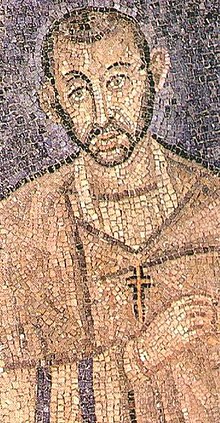Saint Ambrose
|
Saint Ambrose |
|
|---|---|
| Archbishop of Milan | |

Early mosaic of Ambrose that might be an actual portrait.
|
|
| See | Mediolanum |
| Appointed | 374 AD |
| Term ended | April 4, 397 |
| Predecessor | Auxentius |
| Successor | Simplician |
| Orders | |
| Consecration | December 7, 374 |
| Personal details | |
| Born | c. 340 Augusta Treverorum, Gallia Belgica, Roman Empire (modern Trier, Germany) |
| Died | April 4, 397 Mediolanum, Roman Italy, Roman Empire (modern Milan, Italy) |
| Sainthood | |
| Feast day | December 7 |
| Venerated in |
Catholic Church Eastern Orthodox Church Oriental Orthodoxy Anglican Communion Lutheranism |
| Title as Saint | Confessor and Doctor of the Church |
| Attributes | Beehive, a child, whip, bones |
| Patronage | Bee keepers; bees; bishops; candle makers; domestic animals; French Commissariat; geese; learning; livestock; Milan; police officers; students; wax refiners |
| Shrines | Basilica of Sant'Ambrogio |
Aurelius Ambrosius (Italian: Sant'Ambrogio [ˌsantamˈbrɔːdʒo]), better known in English as Saint Ambrose (/ˈæmbroʊz/; c. 340 – 4 April 397), was a bishop of Milan who became one of the most influential ecclesiastical figures of the 4th century. He was the Roman governor of Liguria and Emilia, headquartered in Milan, before being made bishop of Milan by popular acclamation in 374. Ambrose was a staunch opponent of Arianism, and has been accused of fostering persecutions of Arians, Jews, and pagans.
Traditionally, Ambrose is credited with promoting "antiphonal chant", a style of chanting in which one side of the choir responds alternately to the other, as well as with composing Veni redemptor gentium, an Advent hymn.
Ambrose was one of the four original Doctors of the Church, and is the patron saint of Milan. He is notable for his influence on Augustine of Hippo.
Ambrose was born into a Roman Christian family about 340 and was raised in Gallia Belgica (present-day Trier, Germany). His father is sometimes identified with Aurelius Ambrosius, a praetorian prefect of Gaul; but some scholars identify his father as an official named Uranius who received an imperial constitution dated 3 February 339 (addressed in a brief extract from one of the three emperors ruling in 339, Constantine II, Constantius II, or Constans, in the Codex Theodosianus, book XI.5).
...
Wikipedia
